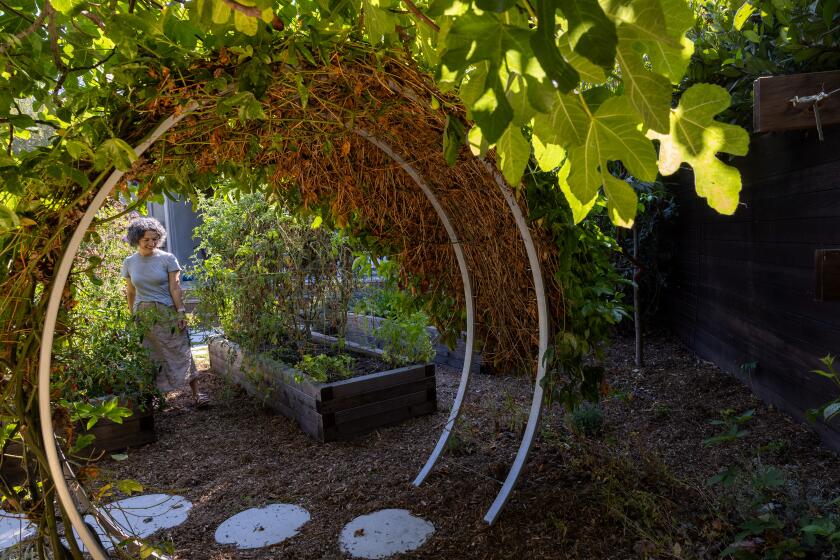They’re Not Natural, But What Is in This Self-Invented Place?
IT’S INEVITABLY DISILLUSIONING FOR a newcomer to learn that the palm trees of Southern California are sort of a trick. What other tricks, one begins to wonder, are being played here?
Palms are a signature of this place, etched into the national psyche by countless Californio-centric movies and television shows: a black-and-white police car rocking to a stop at a fictional crime scene, elevated freeway in the background, spindly Washingtonia robusta palms fluttering high against a shocking blue sky.
The palms are how we know the scene isn’t Chicago on a nice day.
The signature, alas, is a forgery. Of the 2,600 species of palms in the world, the most commonly found in Southern California are the queen, the king, the pygmy date, the Mediterranean fan, the windmill, the Mexican blue fan, the Canary Islands date, the Washingtonia robusta (also called the Mexican fan palm) and the Washingtonia filifera (sometimes called the American Cotton or the California palm). Only the last is a native. All the others have been imposed on the botanically accommodating landscape.
Even Washingtonia filifera didn’t grow naturally on the now-overpopulated coastal plain, but around the oases in the low desert to the east. “The palm is basically an Ice Age leftover,” says Celia Kutcher, curator of the plant collection at the Fullerton Arboretum. “When the climate was wetter, there were more palms.”
Palms love water. Their true American homeland is the humid southeastern states. They abound today in Southern California for one reason--so this will look like the place of sweet indolence that developers have been selling to people from testier climes for 120 years. Palms are still in demand by landscapers and homeowners because “they create a lush, tropical effect that other trees don’t,” says Phil Bergman, president of the International Palm Society and proprietor of Jungle Music, a nursery in San Diego that grows 850 species of palms. “When people go on vacation, why do they go to Hawaii? Not because it’s warm. They could go to the desert if all they wanted was warm.”
A palm-struck newcomer eventually wises up and realizes that Southern California, for all its idyllic tricking-out, is primarily a place of traffic, toil and turgid ambition, where inconvenience often seems so complete that it could only have been intentional. The lovely palms lose their trance-inducing powers. Personal concerns (career, the mating dance, the annual physical exam) reoccupy that part of the mind’s forefront not claimed by the search for a less time-consuming commute. The palm tree becomes just another plant. The process takes, I would say, about a year.
*
I ONCE STOOD ON SAN DIEGO’S PRESIDIO Hill amid regal palm trees and other lush flora while an archeologist told me this site had been chosen for the first Spanish mission in California because it afforded a good view of the ocean and of arriving ships, which were the lifeline of the precarious settlement.
But, I offered, a person can’t really see the ocean very well from here.
“True,” the archeologist said, “but in the time of Junipero Serra, this was a barren hillside. All this greenery today is the result of Colorado River water brought in in the 1940s.”
Botanical truth-brokers such as the California Native Plant Society have been working to restore at least some honesty to the local landscape, which, in its natural semi-desert state, consisted of “grasses and shrubs, and trees in the water courses,” says Kutcher, an official of the society’s Orange County chapter. The original plant species encourage the reestablishment of native fauna, such as certain varieties of butterflies and bees that co-evolved with the plants as pollinators.
“Still, palm trees are nice,” Kutcher says. “They’re beautiful in their own way. For my home landscape, I wouldn’t use them, but the classic Southern California view is of orange trees and palm trees and snow-capped mountains. Even if we went to all native plants everywhere, I’d say we should keep the big, old palm trees, because by now they’re part of our history.”
Palms belong here for another reason. They have a lot in common with the region’s people:
They come from other places.
They have highly regenerative roots, and thus transplant well.
They blend in a mostly eye-pleasing way with other living things of their biological order that they’d never encounter in their places of origin.
They’re probably a more apt symbol of this self-invented place than anything except cell-phone microwave towers, and even those increasingly are disguised to look like palm trees.
*
James Ricci’s e-mail address is [email protected]






